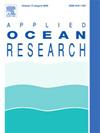Coupled dynamics analysis of floating wind turbine mooring system under extreme operating gust
IF 4.3
2区 工程技术
Q1 ENGINEERING, OCEAN
引用次数: 0
Abstract
Extreme operational gust (EOG), defined by sudden increases in wind speed, is one of the most hazardous situations for wind turbines and the mooring system. A coupled aero-hydro-servo-elastic simulation model is developed using a dynamic link library and a reserved interface between the upper wind turbine and the platform with the mooring system. The blade element momentum (BEM) theory, potential flow theory and lumped-mass model is used to simulate the aerodynamic loads, hydrodynamic forces and mooring tension. The motion response and mooring tension of the OC4-DeepCwind FOWT under EOG are calculated, and the effects of different gust durations and gust amplitudes on the response of the FOWT system are analyzed. It has also been discovered that when gusts and waves cooperate on the FOWT, impact tension occurs in the mooring line, which can cause line breakage. The 107 s interval preceding the peak mooring tension post-EOG emergence presents an opportune moment for an emergency shutdown, with the potential to mitigate maximum tension by 20–42 %. A mooring line break induced by EOG will result in long-distance drift, and a significant reduction in the safety factors of the remaining mooring lines could lead to subsequent breaks. An emergency shutdown following a mooring line break can prevent successive mooring line breaks and limit long-distance drifting. The above study is intended to serve as a reference for future research into the motion performance of the FOWT mooring systems under extreme sea states.
浮式风力涡轮机系泊系统在极端阵风条件下的耦合动力学分析
极端运行阵风(EOG)是指风速突然增加,是对风力涡轮机和系泊系统最危险的情况之一。利用动态链接库和上部风力涡轮机与带有系泊系统的平台之间的预留接口,开发了一个航空-水力-伺服-弹性耦合仿真模型。采用叶片动量(BEM)理论、势流理论和块状质量模型模拟空气动力载荷、流体动力和系泊张力。计算了 OC4-DeepCwind FOWT 在 EOG 下的运动响应和系泊张力,分析了不同阵风持续时间和阵风振幅对 FOWT 系统响应的影响。研究还发现,当阵风和海浪共同作用于 FOWT 时,系泊缆线会产生冲击张力,从而导致缆线断裂。EOG 出现后,系泊张力峰值出现前的 107 秒间隔是紧急关闭的最佳时机,有可能将最大张力降低 20-42%。EOG 引发的系泊缆绳断裂将导致长距离漂移,剩余系泊缆绳安全系数的显著降低可能导致后续断裂。系泊缆绳断裂后的紧急停机可以防止系泊缆绳连续断裂,并限制长距离漂移。上述研究旨在为今后研究 FOWT 系泊系统在极端海况下的运动性能提供参考。
本文章由计算机程序翻译,如有差异,请以英文原文为准。
求助全文
约1分钟内获得全文
求助全文
来源期刊

Applied Ocean Research
地学-工程:大洋
CiteScore
8.70
自引率
7.00%
发文量
316
审稿时长
59 days
期刊介绍:
The aim of Applied Ocean Research is to encourage the submission of papers that advance the state of knowledge in a range of topics relevant to ocean engineering.
 求助内容:
求助内容: 应助结果提醒方式:
应助结果提醒方式:


